To brew beer, various yeast strains are used to metabolize the sugars present (various m

Mmmmm, beer! Source: http://urbanbeerhunt.com/dallas.htm
alts, honey, brown sugar, etc.) into alcohol. Different yeasts are used depending on the desired characteristics of the final product, as they can impart certain flavors based on the side reactions of their metabolism. Based on hundreds of years of traditional practices, many regions around the world use only certain types of yeasts; for instance most Belgian brewers use yeasts that produce a spicy or fruity taste.
Some of the side reactions that occur within yeast result in the produciton of by-products that alter the beer's flavor and can generate off-flavors. This can also occur due to other factors such as the beer being fermented for too long, causing some of the yeast cells to die and release their cellular contents into the beer.
One particular compound is diacetyl. During valine (an amino acid) synthesis acetolactate is formed by the yeast and subsequently leaks into solution, where it spontanesouly decarboxylates to form diacetyl.

Diacetyl. Source:http://en.wikipedia.org/wiki/File:Butandion_-_Butanedione.svg
In many English beers,of a small amount of this compound is not unwanted. It can impart a soft, buttery flavor and also gives the brew a "slippery" mouthfeel. However, outside the realm of British ales the diacetyl is taken to be a flaw. In traditional brewing, diacetyl production is minimized during the aging process (the yeast begin to re-uptake it after primary fermentation is complete). More recently research has aimed to create various yeast strains that minimize diacetyl production.
Two important genes were previously identified as to be involved in diacetyl production: ILV2 and ILV5. The creation of both ILV2 and ILV5 mutant S. cerevisiae strains via genetic engineering has enabled scientists to minimize diacetyl production in experimental settings. The ILV2 gene encodes a product involved in valine synthesis that produces the acetolactate. It was found that upon mutation of the ILV2 gene, the yeast cell's diacetyl production was reduced to half as much diacetyl as the wild-type. The ILV5 gene on the other hand, encodes a product that breaks down acetolacate. Ironically, mutation of this gene results in much higher amounts of acetolactate production, which in turn leads to greatly increased diacetyl concentrations.
More recent work has identified another gene involved in this pathway: ILV6. Upon identifying a low diacetyl-producing strain of yeast, researchers noted that ILV6 expression was un-charateristically low. When this gene was disrupted by genetic engineering, the researchers observed up to a 65% reduciton in diacetyl production.
While this research is interesting and promising to brewers, the commercializaiton of genetically modified organisms faces many obstacles (perhaps rightfully so).
Sources:
Duong, CT et al.Identification of Sc-type ILV6 as a target to reduce diacetyl formation in lager brewers' yeast. (1988)
Gjermansen, C et al. Towards diacetyl-less brewers' yeast. Influence of ilv2 and ilv5 mutations. J Basic Microbiol. (2011)